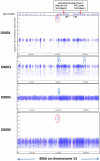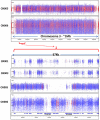Drug-resistant genotypes and multi-clonality in Plasmodium falciparum analysed by direct genome sequencing from peripheral blood of malaria patients
- PMID: 21853089
- PMCID: PMC3154926
- DOI: 10.1371/journal.pone.0023204
Drug-resistant genotypes and multi-clonality in Plasmodium falciparum analysed by direct genome sequencing from peripheral blood of malaria patients
Abstract
Naturally acquired blood-stage infections of the malaria parasite Plasmodium falciparum typically harbour multiple haploid clones. The apparent number of clones observed in any single infection depends on the diversity of the polymorphic markers used for the analysis, and the relative abundance of rare clones, which frequently fail to be detected among PCR products derived from numerically dominant clones. However, minority clones are of clinical interest as they may harbour genes conferring drug resistance, leading to enhanced survival after treatment and the possibility of subsequent therapeutic failure. We deployed new generation sequencing to derive genome data for five non-propagated parasite isolates taken directly from 4 different patients treated for clinical malaria in a UK hospital. Analysis of depth of coverage and length of sequence intervals between paired reads identified both previously described and novel gene deletions and amplifications. Full-length sequence data was extracted for 6 loci considered to be under selection by antimalarial drugs, and both known and previously unknown amino acid substitutions were identified. Full mitochondrial genomes were extracted from the sequencing data for each isolate, and these are compared against a panel of polymorphic sites derived from published or unpublished but publicly available data. Finally, genome-wide analysis of clone multiplicity was performed, and the number of infecting parasite clones estimated for each isolate. Each patient harboured at least 3 clones of P. falciparum by this analysis, consistent with results obtained with conventional PCR analysis of polymorphic merozoite antigen loci. We conclude that genome sequencing of peripheral blood P. falciparum taken directly from malaria patients provides high quality data useful for drug resistance studies, genomic structural analyses and population genetics, and also robustly represents clonal multiplicity.
Conflict of interest statement
Figures



Similar articles
-
Amplicon deep sequencing improves Plasmodium falciparum genotyping in clinical trials of antimalarial drugs.Sci Rep. 2019 Nov 28;9(1):17790. doi: 10.1038/s41598-019-54203-0. Sci Rep. 2019. PMID: 31780741 Free PMC article.
-
Quantitative genome re-sequencing defines multiple mutations conferring chloroquine resistance in rodent malaria.BMC Genomics. 2012 Mar 21;13:106. doi: 10.1186/1471-2164-13-106. BMC Genomics. 2012. PMID: 22435897 Free PMC article.
-
Genetic diversity of Plasmodium falciparum parasites from Kenya is not affected by antifolate drug selection.Int J Parasitol. 2002 Nov;32(12):1469-76. doi: 10.1016/s0020-7519(02)00164-9. Int J Parasitol. 2002. PMID: 12392912 Clinical Trial.
-
Folic acid supplementation and malaria susceptibility and severity among people taking antifolate antimalarial drugs in endemic areas.Cochrane Database Syst Rev. 2022 Feb 1;2(2022):CD014217. doi: 10.1002/14651858.CD014217. Cochrane Database Syst Rev. 2022. PMID: 36321557 Free PMC article.
-
Genetic structure and dynamics of Plasmodium falciparum infections in the Kilombero region of Tanzania.Trans R Soc Trop Med Hyg. 1999 Feb;93 Suppl 1:11-4. doi: 10.1016/s0035-9203(99)90321-8. Trans R Soc Trop Med Hyg. 1999. PMID: 10450420 Review.
Cited by
-
Structural polymorphism in the promoter of pfmrp2 confers Plasmodium falciparum tolerance to quinoline drugs.Mol Microbiol. 2014 Mar;91(5):918-34. doi: 10.1111/mmi.12505. Epub 2014 Jan 23. Mol Microbiol. 2014. PMID: 24372851 Free PMC article.
-
A barcode of organellar genome polymorphisms identifies the geographic origin of Plasmodium falciparum strains.Nat Commun. 2014 Jun 13;5:4052. doi: 10.1038/ncomms5052. Nat Commun. 2014. PMID: 24923250 Free PMC article.
-
Repeat polymorphisms in the low-complexity regions of Plasmodium falciparum ABC transporters and associations with in vitro antimalarial responses.Antimicrob Agents Chemother. 2013 Dec;57(12):6196-204. doi: 10.1128/AAC.01465-13. Epub 2013 Sep 30. Antimicrob Agents Chemother. 2013. PMID: 24080667 Free PMC article.
-
Complex polymorphisms in the Plasmodium falciparum multidrug resistance protein 2 gene and its contribution to antimalarial response.Antimicrob Agents Chemother. 2014 Dec;58(12):7390-7. doi: 10.1128/AAC.03337-14. Epub 2014 Sep 29. Antimicrob Agents Chemother. 2014. PMID: 25267670 Free PMC article.
-
Impact of an Irrigation Dam on the Transmission and Diversity of Plasmodium falciparum in a Seasonal Malaria Transmission Area of Northern Ghana.J Trop Med. 2020 Mar 19;2020:1386587. doi: 10.1155/2020/1386587. eCollection 2020. J Trop Med. 2020. PMID: 32308690 Free PMC article.
References
-
- Meyer CG, May J, Arez AP, Gil JP, Do Rosario V. Genetic diversity of Plasmodium falciparum: asexual stages. Trop Med Int Health. 2002;7:395–408. - PubMed
-
- Nicastri E, Paglia MG, Severini C, Ghirga P, Bevilacqua N, et al. Plasmodium falciparum multiple infections, disease severity and host characteristics in malaria affected travellers returning from Africa. Travel Med Infect Dis. 2008;6:205–209. - PubMed
-
- Färnert A, Tengstam K, Palme IB, Bronner U, Lebbad M, et al. Polyclonal Plasmodium falciparum malaria in travellers and selection of antifolate mutations after proguanil prophylaxis. Am J Trop Med Hyg. 2002;66:487–491. - PubMed
-
- Kilama W, Ntoumi F. Malaria: a research agenda for the eradication era. Lancet. 2009;374:1480–1482. - PubMed
Publication types
MeSH terms
Substances
Grants and funding
LinkOut - more resources
Full Text Sources
Medical

